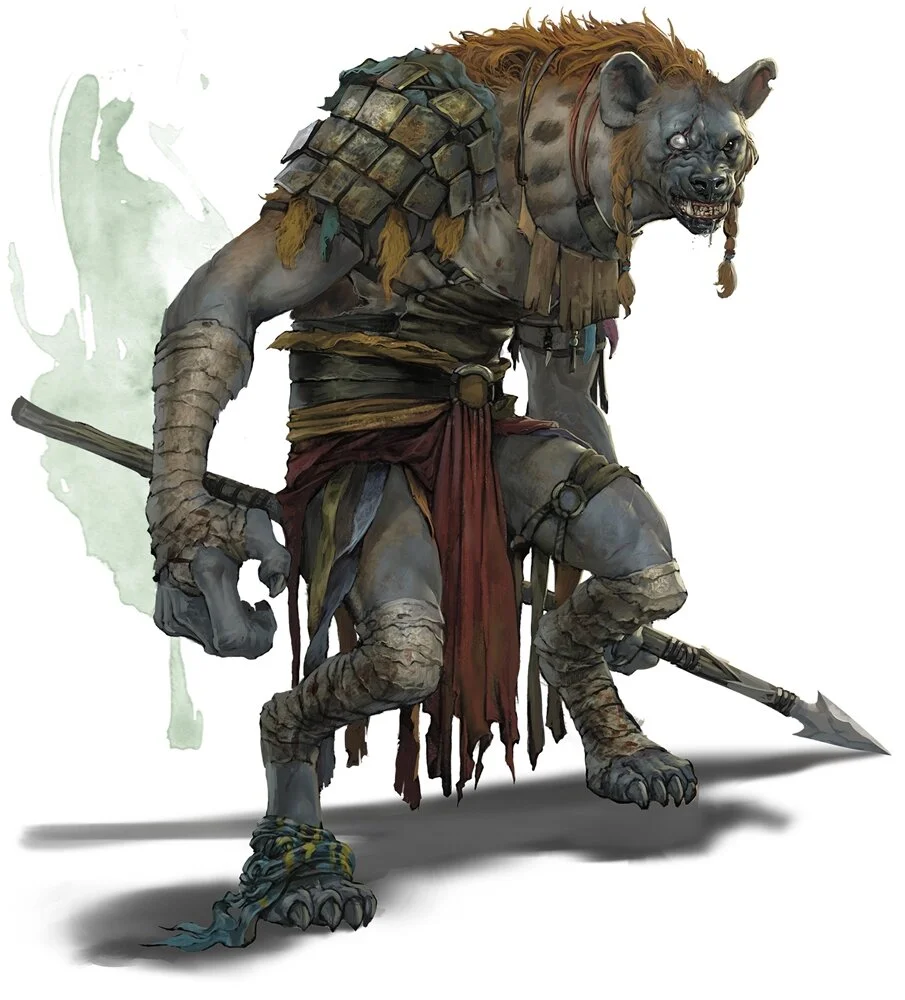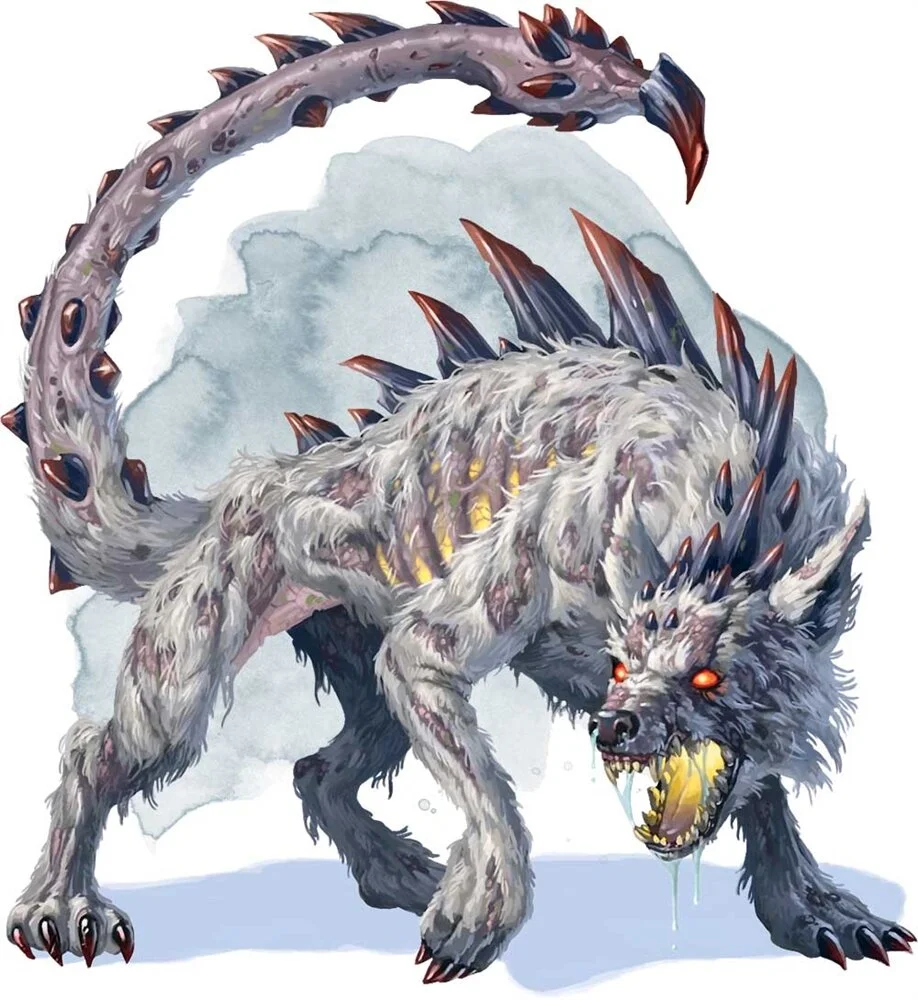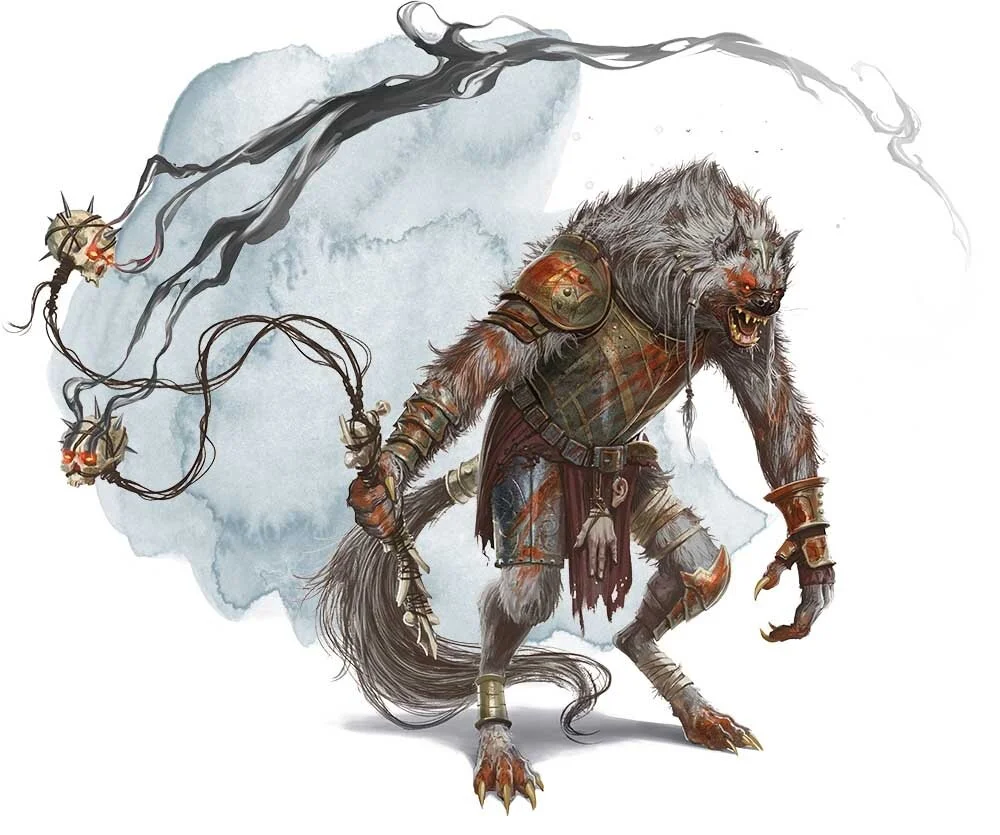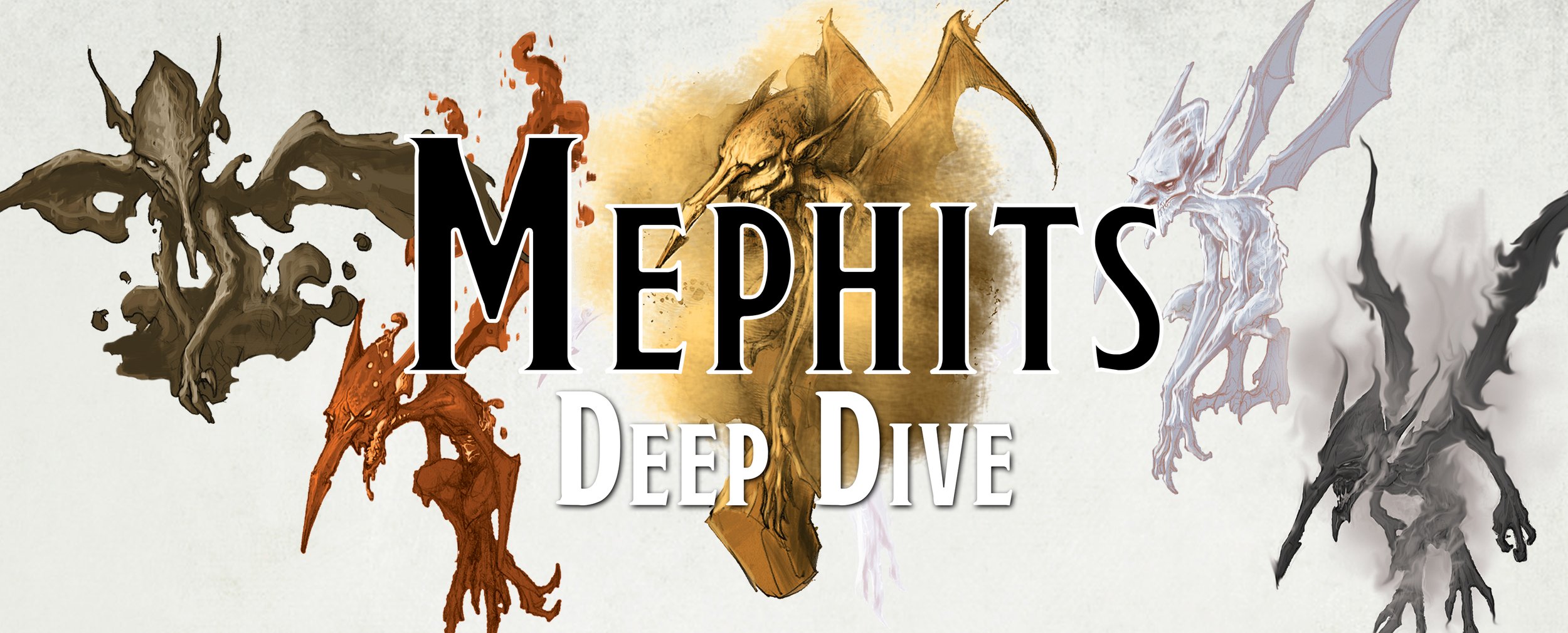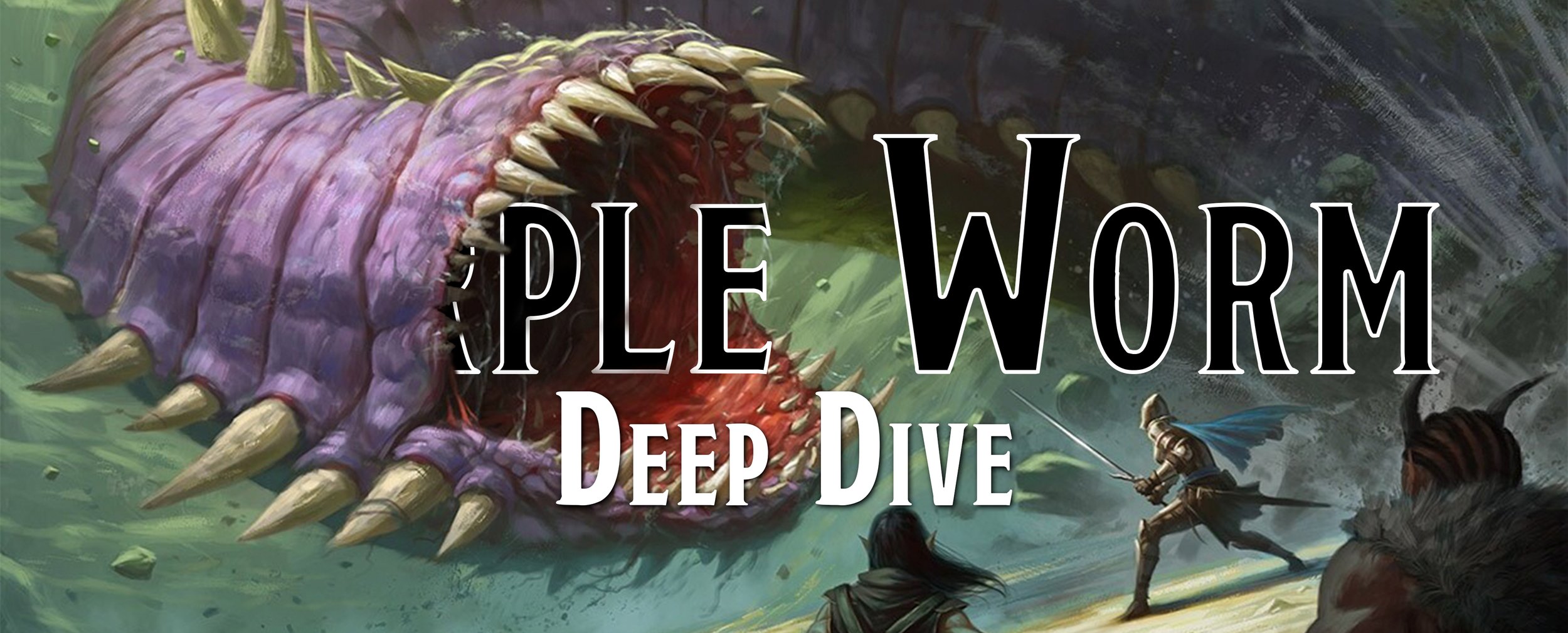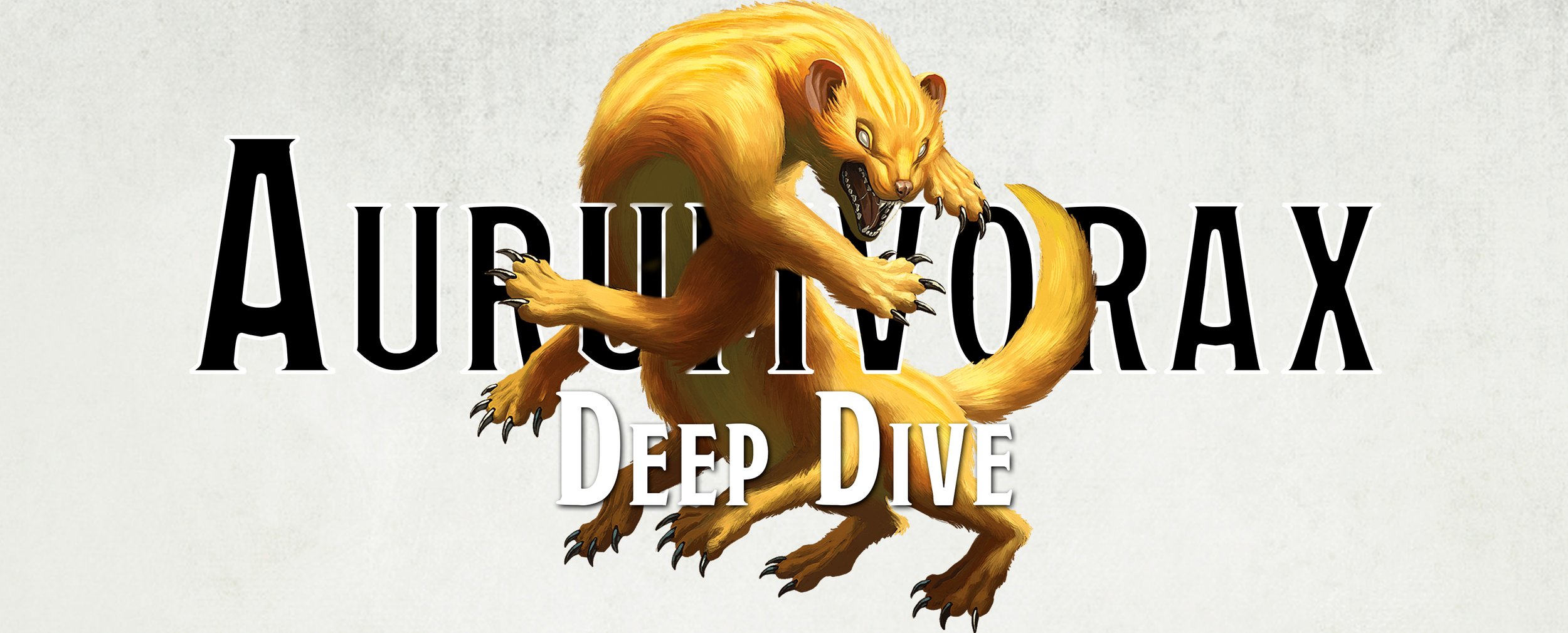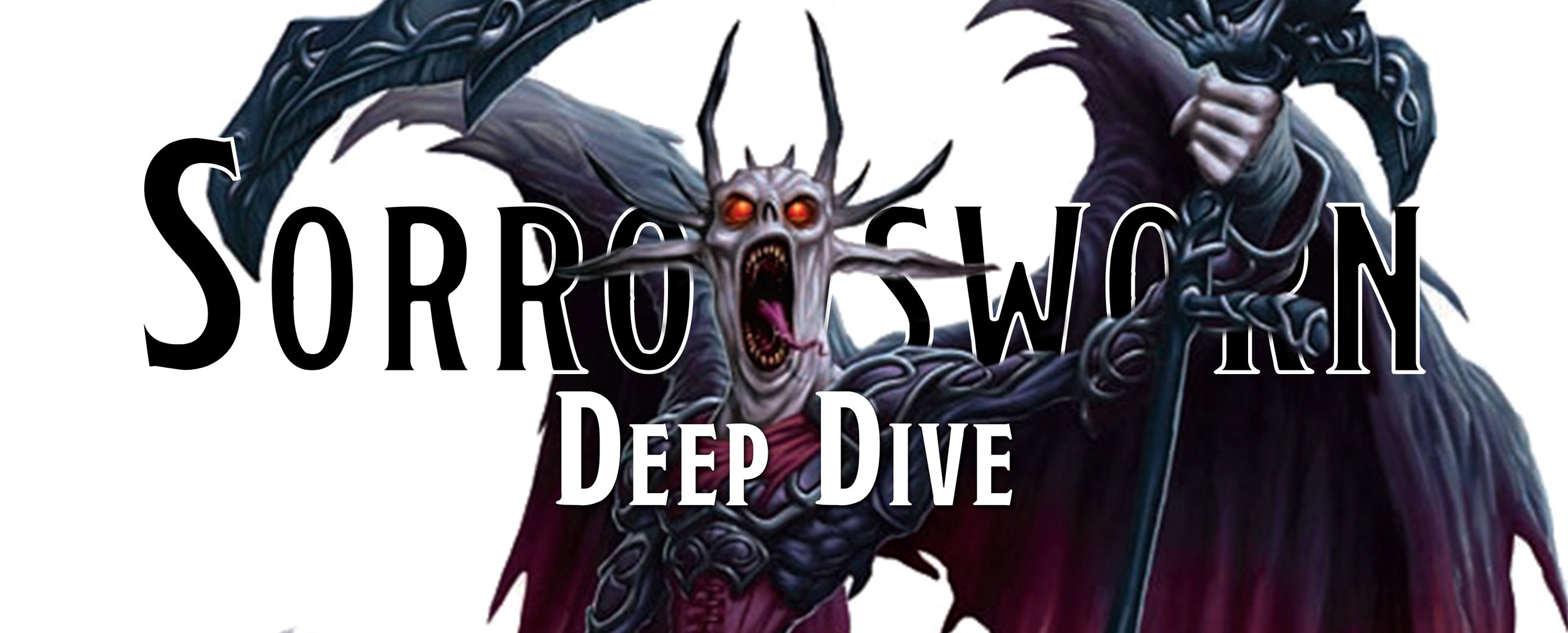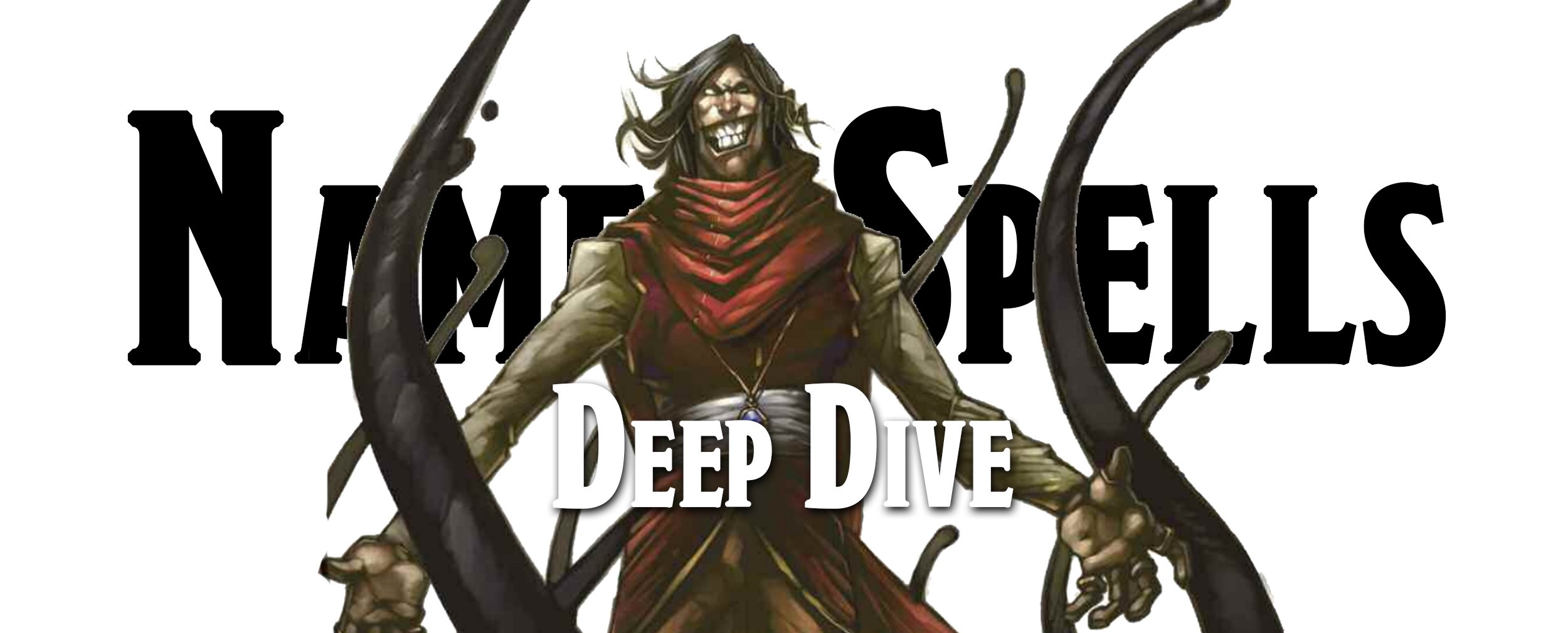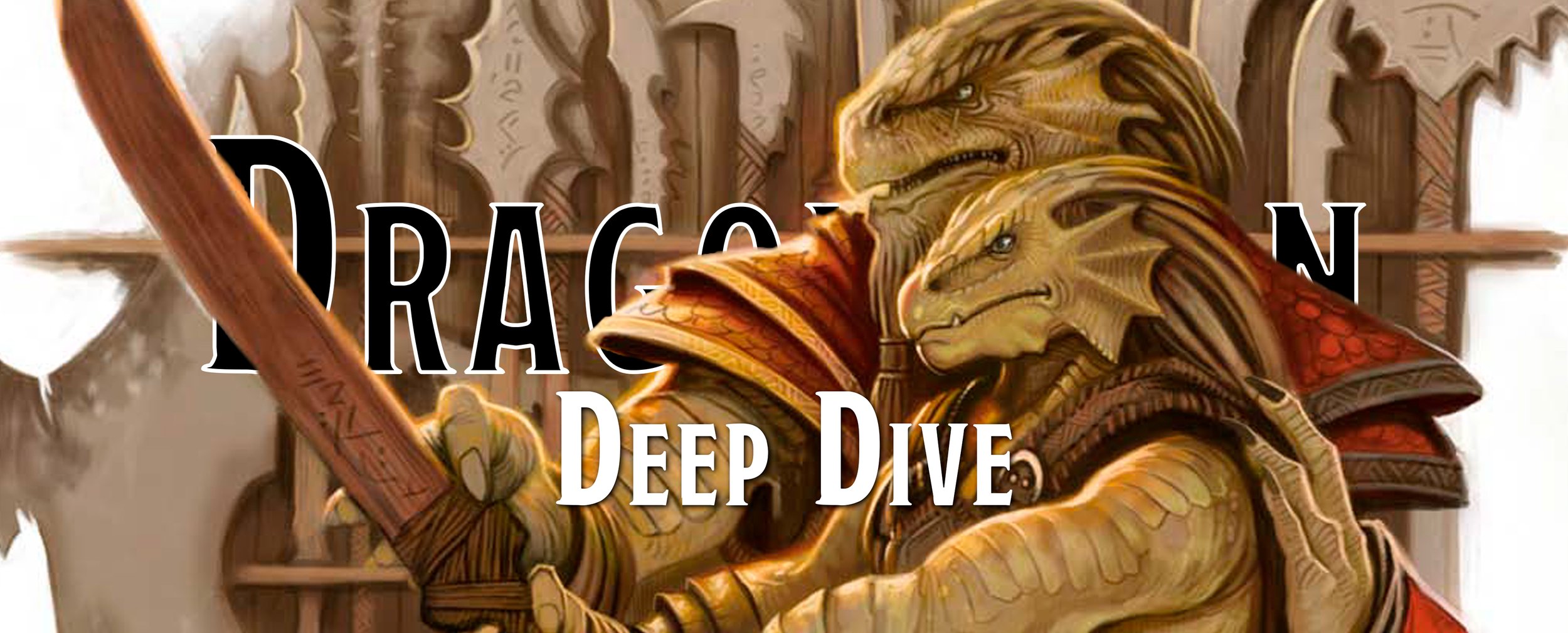Deep Dive - The Gnoll
One of the original low-level monsters to be slaughtered in the ancient dungeon delves of old, the Gnoll has been through a lot. While other monstrous humanoids, like the goblins, hobgoblins, kobolds, and orcs, have all gotten a chance to be loved (somewhat) the Gnoll is just kind of… there. From being the brunt of a rather bad joke in the earliest edition to being created by a demon, the Gnolls have had a rough go of it, even if some editions have tried to do more with them or settings have tried to put a spin on them.
OD&D - Gnoll
No. Appearing: 20-200
Armor Class: 5
Move: 9”
Hit Dice: 2
% in Lair: 30%
No. of Attacks: 2
Damage/Attack: 1-8 or by weapon type
Treasure: Type D
We are first introduced to the Gnoll in the White Box Set - Book 2: Monsters & Treasures (1973). As all but for a few select monsters in the original edition, there is scant information about the Gnoll. What little we do get is a bit disturbing and is pretty much a bad joke. Described as a cross between gnomes and trolls, we are left to wonder how that would ever work. Of course, this is just a joke because it is a combination of gnome and troll.
That’s pretty much the culmination of lore in the early days of Dungeons & Dragons. Gnolls were only meant to be killed by others and thus had a joke for a personality and background. But we are nothing if not thorough.
A troll is tall and rubbery with long vicious talons and fangs and can regenerate, even after it has been struck down and killed. A gnome, on the other hand, is described as being a cousin to the dwarves but is slightly smaller. Gnomes have beards longer than dwarves and like to reside within the hills instead of mountains, other than that there is no difference between the two.
Going back to the Gnoll, the only thing this creature has going for it is that it gains a +2 bonus to morale checks so that they don’t break during combat. It’s considered to be similar to hobgoblins but has an additional hit die for its health and makes an additional attack every round. After that, we find out that the Gnoll king and bodyguards fight as trolls, meaning that they get to make six attacks a round and have, unlike the normal Gnoll, 6 hit die but no regeneration. This means if you are stumbling around the lower levels of a dungeon, and find a room of hobgoblins and another room of gnolls, you should just run away.
The last interesting tid bit that can be gleaned from this edition is that elves can speak gnoll. No reason is given for it, but elves can also speak elf, orc, and hobgoblin so maybe it’s because they just understand inherent fey-like creatures? It probably has to do with Tolkien and his Lord of the Rings series.
Basic D&D - Gnoll
Armor Class: 5
Hit Dice: 2
Move: 90’ (30’)
Attacks: 1 weapon
Damage: 2-8 or by weapon +1
No. Appearing: 1-6 (3-18)
Save As: Fighter 2
Morale: 8
Treasure Type: D
Alignment: Chaotic
Gnolls first arrive in this edition as a single line stat block in the 1977 Dungeons & Dragons Basic Set based on the rules outlined in the original version. The Gnoll is not provided any lore and is just listed as one of the numerous other monsters you may stumble across in a dungeon.
It’s not until 1981 that the Gnoll gets a chance to revisit their lore and give them a purpose and meaning in life. In the Moldvay/Cook Basic Box Set (1981), and later again in the 1983 Basic Set, the Gnoll is given a description that is not that much longer than the previous one in OD&D, but at least it doesn’t start with a joke. Of course, it may have been too much to hope for a nice background on the Gnoll instead, well…
The insults begin immediately as they are called “beings of low intelligence” in the very first line of the descriptive text. No one likes to be told they are of low-intelligence, but to lead with that right out of the gate makes it that much more hurtful. In the same sentence where we discuss their intelligence, they are also described as human-like hyenas. After that, it explains they can use any weapon, that they are strong, dislike working, and prefer to bully and steal from others. Not a great start for the Gnoll, but it’s better than that joke from before where… oh, nevermind that’s still here.
The last sentence shares a rumor that Gnolls are from the magical experimentation of an evil wizard combining a gnome and a troll. Of course, it’s a bit difficult to exactly pinpoint how that rumor would ever get started seeing as neither gnomes or trolls look like hyenas.
Unfortunately for the Gnoll, this wasn't an edition to be celebrated, but we can only hope it gets a bit better for them in the Advanced Dungeons & Dragons.
AD&D - Gnoll
Frequency: Uncommon
No. Appearing: 20-200
Armor Class: 5
Move: 9”
Hit Dice: 2
% in Lair: 20%
Treasure Type: Individuals L, M; D, Q ( x 5), S in lair
No. of Attacks: 1
Damage/Attack: 2-8 or by weapon type
Special Attacks: Nil
Special Defenses: Nil
Magic Resistance: Standard
Intelligence: Low-average
Alignment: Chaotic Evil
Size: L (7+ tall)
Psionic Ability: Nil
Monster Manual, 1977 TSR Inc.
The Gnoll is shown a little more love in this edition and can be found in the Monster Manual (1977). No longer a twisted gnome/troll combination, but their typical hyena-like humanoid appearance. While there are a lot of similarities between hyenas and Gnolls, the Gnoll features fur with a greenish-gray hue, they walk around on two legs and swing a sword - maybe not as many similarities as one would think.
While we are talking about their appearance and equipment, let’s first go over that. All Gnolls wield swords, though some may wield bows, polearms, two-handed swords, axes, and even morning stars. They scavenge what weapons they can find off of whoever they just recently killed and take any armor and equipment they can find. Speaking of armor, it’s a makeshift combination at best. Leather, metal plates, furs, and helms all stitched together and forming an armor that is pretty spotty at best. While the Gnolls are considered lazy in this edition, you’d think that they’d at least take care of their weapons and armor but it’s called motheaten and dingy. We suppose if you only live for 35 years, like a Gnoll, you’d run out of time to clean your equipment once and a while.
Looking at Gnoll society at large, they are a mean and vicious lot, with the powerful ruling over the weak. They don’t have any ordained kings, but rather whoever is the strongest gets to lead the others around, though that power doesn’t extend very far. Gnolls travel in very independent packs that will occasionally band together with others and take on a stronger foe or loot a larger city that they wouldn’t be able to handle by themselves.
Speaking of cities, the vast majority of time Gnolls can be found beneath the ground in caves and dungeons. Only rarely will they ever poke their heads up and take up residence in ancient ruins or a recently vacated village. Seems a bit odd to us that they are underground creatures, but we suppose that is just part of being a monster in Dungeons & Dragons, a lot of creatures are going to be found in dungeons.
Monster Manual, 1977 TSR Inc.
Apart from just the Gnolls, we are also given information in the Monster Manual about the Demon Prince of Gnolls, Yeenoghu. There is no clear information about the relationship between Demon Prince and Gnolls except that there are always 66 Gnolls near him and that if he ever has 0 Gnolls around him, he can summon up to 66 of them… or summon up to 16 ghouls as the King of Ghouls owes allegiance to him.
Yeenoghu is said to resemble a human in the general sense of the term, but upon gazing on him, you realize that that is just a blatant lie. Hyena head, chest of a canine, and paw-like hands and feet. He is also extremely thin as to almost be skeletal and is covered in a putrid yellow fur that is matted and mangy. He’s not exactly a handsome boy, but the other Gnolls seem to like him well enough.
Deities & Demigods, 1980 TSR Inc.
Except that that isn’t entirely true. In the 1980 book, Deities & Demigods, Yeenoghu has a tiny paragraph explaining that Gnoll shamans keep their kind worshipping him through fear. They enforce their worship by reminding the Gnolls that Yeenoghu is not a very gentle creature and if he is slighted, and not worshipped properly, he will bring his wrath down on any who try to go against him. His clerics can reach to such esteemed heights of being a 5th-level cleric which is… well, good for them.
Fiend Folio, 1981 TSR Inc.
In the Fiend Folio (1981), we are introduced to our next kind of Gnoll, the Flind. These creatures are very charismatic, at least to all Gnolls who assume them to be some sort of higher power. The Flind sometimes act as the leader of a pack of Gnolls, as it is more powerful than a normal Gnoll. The most interesting thing about the Flind isn't the creature itself, seeing as how it is just a cousin of the Gnoll, but it’s weapons. One of the weapons it likes to carry and wield into battle is known as the flindbar, a chain-linked bar that whips around the Flind and strikes out twice per round with it. While attacking twice is great and all, the flindbar's most significant feature is its ability to disarm the target of their weapons. If you can defeat the Flind and it’s pack of howling Gnolls, you too can use the flindbar, as long as you have a high enough Strength and Dexterity and can train with it.
Dragon #63, TSR Inc. 1982
The Gnoll gets a little more love, if you can call it that, as they get mentioned in Roger Moore's article in Dragon #63 - The Humanoids (July 1982). Much of the information we know already, but there are a few new pieces of information worth mentioning like... Gnolls are the most sexists of all the monstrous humanoids, and we are including orcs, goblins, kobolds, hobgoblins, and so many others in that statement. Since the race as a whole looks upon physical labor as the worst thing in existence, they place all those types of responsibilities on the females treating them as slaves and worse. They are chaotic creatures as they value personal independence more than anything, and it is only through a deep racial bond and sense of loyalty that a pack doesn't tear each other to pieces. We also find out that Gnolls have shamans within their society, and that they have been known to use ghouls or possibly other undead as guards thanks to Yeenoghu’s connection to the undead. Don't know about you, but we wouldn't want ghouls hanging around the camp, even if they are there for our protection.
Dragon #63, TSR Inc. 1982
In addition to just, frankly a rather awful expanded lore, this article also is the first chance we get to look upon the Shoosuva. A Shoosvua is a fiend/undead hyenodon that resembles a hyena but has phosphorescent green skin/fur and Yeenoghu sends this creature to his most powerful shaman. The Shoosuva is a messenger of sorts, though it is quite powerful and can compel all nearby Gnolls to fight to the death and slaughter its enemies. While a Gnoll shaman can summon a Shoosuva by using a specially crafted talisman, created from the bones of another Gnoll shaman, they can’t really control the Shoosuva, it just does what it wants. Once it is done, the Gnoll shaman must then provide it food in the form of carrion, thus all Gnoll shamans who summon these creatures always has purify food and water prepared to cast it on a dead body after the battle. If they fail to feed their demon-puppy, the Shoosuva will never return and they’ll be blacklisted by Yeenoghu who won’t send them any more pets.
Dragon #89, TSR Inc. 1984
The final mention of Gnolls for this adventure is in the Creature Catalog found in Dragon #89 (September 1984). This is the first time the Creature Catalog appears in the Dragon magazines and is fanmade monsters sent in to be featured in the magazine. It was a short-lived section that produced over a hundred unique creatures, sadly only a small handful have survived the editions like the nagpa or the cave fisher. The creature we are looking at is the new relative to the Gnoll, the Ghuuna. This semi-were-creature is a race created by Yeenoghu and is kind of like the curse of lycanthropy, even in regards to transforming under a full moon. Gnolls affected by the strange form of lycanthropy transforms into a hyenodon. What is a hyenodon, you ask? They are a giant prehistoric hyena. As with other were-creatures, if a Gnoll is bitten by a Ghuuna when they are in their hyenodon form, they too get to become a Ghuuna. The Ghuuna have control over hyenas and hyenodons, and can be summoned by Gnoll shamans.
2e - Gnoll
Climate/Terrain: Any tropical to temperate non-desert
Frequency: Uncommon
Organization: Tribe
Activity Cycle: Night
Diet: Carnivore
Intelligence: Low (5-7)
Treasure: D, Qx5, S (L,M)
Alignment: Chaotic Evil
No. Appearing: 2-12
Armor Class: 5 (10)
Movement: 9
Hit Dice: 2
THAC0: 19
No. of Attacks: 1
Damage/Attack: 2-8 (2d4) (weapon)
Special Attacks: Nil
Special Defenses: Nil
Magic Resistance: Nil
Size: L (7 1/2’ tall)
Morale: Steady (11)
XP Value: 35; Leaders & Guards: 65; Leader: 120; Chieftan: 120
Monstrous Compendium - Volume 1, 1989 TSR Inc.
Gnolls first come into 2nd edition in the Monstrous Compendium - Volume 1 (1989) and then reprinted in the Monstrous Manual (1993). They are depicted as a tall humanoid, considered a large creature, and has the head and legs of a hyena. Not much of their physical aspects are changed though, and they are still considered to be quite evil and players shouldn’t feel bad for killing them. Beyond the Gnoll, the flind also returns and has hit the big time, with its stat block right next to the Gnoll in both books!
We find out a bit more about their ecology, especially in regards to what they like to eat, which is anyone or anything. If it is made of meat, the Gnolls are going to snack on it. If a pack of Gnolls encounters another group, be it trolls, Gnolls, orcs, hobgoblins, humans, or pretty much anything, the other group must be of relative equality of strength. Otherwise, the Gnolls are eating that night, and it's going to be the other group. Even if the other party is of equal strength, the Gnolls are still known to partner up with them and then, once that group takes some casualties and is no longer on equal footing, will turn on them and end the partnership with a feast.
Monstrous Manual, 1993 TSR Inc.
It’s not just that Gnolls are carnivores, and thus will consume all creatures, but also that they are very cruel. They enjoy eating more intelligent beings as the smarter creatures tend to make the best screams and they enjoy hearing it as they begin eating them. This is especially a problem for other creatures because Gnolls will stick around in an area until every beast, humanoid, or other forms of life are killed and consumed, they will then move on to a new area to over hunt. When they over hunt an area, it may take years and years before it can ever begin the process of recovering from their onslaught.
In the Complete Book of Humanoids (1993), we are presented with the Gnoll and Flind as a player character options. You're not going to be the nicest person in the world, and you are limited to playing a fighter, cleric, shaman, witch doctor, or thief. The accompanying information also provides roleplaying tips for playing a Gnoll, informing players that player character Gnolls are not typically chaotic evil, but rather of a neutral alignment and that these are special Gnolls that have somehow found enlightenment despite their cultural upbringing. The most likely type of Gnoll to be a player character is the Flind as they have a natural desire to be loved and celebrated by others, even if they are quite tasty and sentient.
In Dragon #173 (September 1991), Spike Jones takes a long look at the sociology of the Flind through a story involving small children, a one-armed bard, and an unpaid debt to an adoptive flind father figure. It's a little bit of a convoluted story, but we'll explain it the best we can. A group of adventurers, including the bard, are sent to deal with some nearby Gnolls causing issues. They easily cut through the small packs of Gnolls they do find, and each time the Gnolls would surrender but their mighty warrior in the party thinks surrender is an act of cowardice and slays them anyways. Eventually, they find the large horde of Gnolls and decide to destroy the entire clan then and there. Unfortunately for them, they thought the entire clan to be just Gnoll and not include the far more intelligent Flind who led them into a trap. The Flinds sacrificed several Gnolls to lure the adventurers into thinking they were gaining the upper hand, but once the adventurers were where they wanted, the Flinds sprung their ambush. The adventurers went down easily, and all that remains is the bard who surrenders, mimicking how the other Gnolls had surrendered.
Dragon #173, 1991 TSR Inc.
Luckily, this worked for him and the Gnolls accepted it. They then began trying to find a language he understood, settling on Orc. Once they found a language, they began discussing in that tongue how to mutilate, eat, torture, or kill the surviving bard. They enjoyed torturing the bard with images of how they might do it, getting increasingly graphic as they continued. Eventually, a Flind decided to adopt the bard as the bard’s companions had killed his child and he was looking for a new child to take its place. While not everyone was excited about it, they accepted the Flind’s decision due to how powerful he was as a cleric to Yeenoghu. Over the next year, the bard learned all about the harsh upbringing of Flind youth and saw firsthand how Yeenoghu allowed his clerics to raise the dead into ghouls and ghasts. Eventually, the bard found an opening during an attack against an orc encampment and was able to escape.
It’s been 10 years since he escaped, and the Gnolls have tracked him down and are here to see if he will become an adult Flind. See, when he was ‘rescued’ by his Flind father, the other Flinds were upset with this decision and warned him and his new father that if he failed to become an adult, the entire line of Flind that ‘adopted’ the bard would be tortured and killed for introducing weakness into their clan.
Dragon #173, 1991 TSR Inc.
To become an adult Flind, all clans have a totem race of prey who they just love to kill the most, the most common totem races are who you think they would be - humans, gnomes, elves - basically any humanoid race will do. There are a couple of rituals in place utilizing the unfortunate totem race, but the common theme behind all of them is trying to gain the favor of their god Yeenoghu. The end of the story informs the reader about the more critical rituals in Gnoll culture. A young Gnoll must kill one of the totem races before they are seen as an adult Gnoll in the eyes of the clan. Failing to kill a totem race ends up with the death of that Gnoll as well as it’s family for allowing such a weak child to weaken the clan.
The bard departs with the Gnolls, hoping to survive the night as he must hunt down an orc, and kill it before the sun rises in the distance. If he fails that, the Gnolls and Flinds will attack his new home, killing and destroying everyone and everything he loves. It’s a bit of an odd tale but is a more interesting read than the lore provided in the Monster Manuals.
3e/3.5e - Gnoll
Medium Humanoid (Gnoll)
Hit Dice: 2d8+2 (11 hp)
Initiative: +0
Speed: 30 ft. (6 squares)
Armor Class: 15 (+1 natural, +2 leather armor, +2 heavy steel shield), touch 10, flat-footed 15
Base Attack/Grapple: +1/+3
Attack: Battleaxe +3 melee (1d8+2/x3) or shortbow +1 ranged (1d6/x3)
Full Attack: Battleaxe +3 melee (1d8+2/x3) or shortbow +1 ranged (1d6/x3)
Space/Reach: 5 ft./5 ft.
Special Attacks: -
Special Qualities: Darkvision 60 ft.
Saves: Fort +4, Ref +0, Will +0
Abilities:Str 15, Dex 10, Con 13, Int 8, Wis 11, Cha 8
Skills: Listen +2, Spot +3
Feats: Power Attack
Environment: Warm plains
Organization: : Solitary, pair, hunting party (2–5 and 1–2 hyenas), band (10–100 plus 50% noncombatants plus 1 3rd-level sergeant per 20 adults and 1 leader of 4th–6th level and 5–8 hyenas), or tribe (20–200 plus 1 3rd-level sergeant per 20 adults, 1 or 2 lieutenants of 4th or 5th level, 1 leader of 6th–8th level, and 7–12 hyenas; underground lairs also have 1–3 trolls)
Challenge Rating: 1
Treasure: Standard
Alignment: Usually chaotic evil
Advancement: By character class
Level Adjustment: +1
Monster Manual, 2000 WotC
The Gnoll shows up in the Monster Manual (2000/2003) where they fully embrace their hyena heritage and act like murder-hobo humanoids that rival even the most bloodthirsty players. Looking through the description, there are very few changes. Once again, we are told that they are carnivores that love to eat smart creatures since it’s just more entertaining and that they are a brutal society. We know that is nothing new, but it's still disturbing, so we figured we'd share it again. They hate giants, and while they weren't on friendly terms with them before, the text goes out of the way to tell us about giants specifically - which is a twist as they used to despise everyone equally.
Now, in combat, we already knew that Gnolls fight with minimal strategy, especially since they don't like being told what to do. Of course, if there is a strong and cruel leader, then they will follow orders and will set up ambushes and flanking positions. Though, they still very rarely lay actual traps instead of just using superior numbers and attacking flanks until their prey gives up and they take a bunch of slaves for future meals.
While little changes in this edition, we get two major things in this edition. The Gnolls are no longer considered large, and instead are just medium. We also get something far more important with huge ramifications that might affect the Gnolls of all tribes! While they revere Yeenoghu, they don’t worship him. Instead, if they are going to worship someone, they are going to worship one from Greyhawk known as Erythnul an Oeridian god of Hate, Envy, Malice, Panic, Ugliness, and Slaughter.
Monster Manual III, 2004 WotC
In 2004 the Monster Manual III is released and the Flind returns and… not much changes, surprise. They are still the more powerful of the Gnolls, and they still don’t think much of their weaker cousins. They are often the leaders of Gnoll packs and still wield their fearsome flindbars to devastating effects.
Races of the Wild, 2005 WotC
Up next is Races of the Wild (2005) which provides us with a wealth of knowledge on how to roleplay the Gnoll as well as defining how a player could make a Gnoll into a Player Character. Being cruel and vicious is still the common practice when playing a Gnoll, but now that's not your only option. For those Gnolls that have turned away from Yeenoghu, their natural temperament also includes a sense of honor and loyalty to those that they travel with and consider part of their pack. Gnolls will name special people a pack brother, and once they do so, they bond between the Gnoll and this person is unwavering and forever. It's not an easy title to come by, as Gnolls are suspicious of most other races. Being a Gnoll character means that you'll love being out in the world, traveling and looking for adventure, as it is a big part of the Gnoll's nature, of course, you still crave fresh meat from sentient creatures, so your party will have to meet you halfway. The further a Gnoll travels, the happier they are, so if you are playing a Gnoll, that quest on the other side of the continent will sound like a great idea to you.
Monster Manual IV, 2006 WotC
The last bit of Gnoll lore we will cover for this edition makes its way in the Monster Manual IV (2006) which features several new Gnolls to populate the raiding parties. The new Gnolls are the Slave-Taker, the Fiendish Cleric of Yeenoghu, and the Half-Fiend Gnoll Warlock. Each of them have valued places in Gnoll society, well, maybe not all of them are incredibly valued. Slave-takers are the lowest rung of Gnoll society and are in charge of overseeing the slaves and capturing them during combat. They are only listened to when it comes to capturing slaves, otherwise, they are beaten and abused just like the slaves are, in turn, they take out their anger on the slaves.
After them, are the fiendish clerics who are the offsprings of demons that Yeenoghu sends and the Gnolls of that tribe. These creatures have a closer connection to the Demon Prince and are given clerical powers like healing, creating spiritual weapons, and more. Most clerics don’t propagate the worship of Yeenoghu, but rather act as advisors to the Gnoll pack lords. Similar to the clerics are the half-fiend warlocks, they are also partly fiendish, with their parents having been fiends, but they are far more powerful. They often become the leaders of the pack, and with the dark powers granted to them by Yeenoghu, rarely have anyone willing to challenge them on it. Also, their fiendish heritage gives them horns, leathery wings, and hooves of a goat, creating a much more horrifying appearance than the typical Gnoll.
In addition to the new types of Gnolls, the book also provides additional information about the society of Gnolls. When Gnolls travel to a new location, they begin marking their territory, not with their musk but by taking one of their lesser members and biting and ripping their throat out. They then draw the sigils of their clan with the blood on the outskirts of their territory as a warning to other Gnoll packs that this is their property. The pack leader repeats this process throughout their territory to denote which places are for childrearing, to ensure that the other Gnolls don’t decide to snack on the baby Gnolls, and also where the living quarters are. After that, it’s up to the other Gnolls to fight for the best spots in a cave, forest, or wherever their new home is.
Dragon #112, 2004 WotC
Alright, so we have one last thing to cover for this edition. We promise! In Dungeon Magazine #112 (July 2004), the Shoosuva returns in the back appendix as a new monster for 3e. It’s a bit of a relief that it returns, because of all the Gnoll lore, we actually like the Shoosuva. It’s a brief description of the hyena-demon-undead creature, and yes you read that right. It's an undead demon hyena which… it has a lot going on. Yeenoghu created these cute puppies, naming them Returner in the Gnoll tongue, Shoosuva, and uses them to communicate with his clerics and priests. He included many parts of his favorite undead, ghouls, into their form like giving them a paralytic bite that not only drains strength and dexterity but also paralyzes a creature. They are pretty tough creatures to face and are often sent to aid Gnoll packs, so long as they are loyal to Yeenoghu and keep up their bloody sacrifices to him.
4e - Gnoll
Gnoll Huntmaster Level 5 Artillery
Medium natural humanoid / XP 200
Initiative +6 / Senses Perception +11; low-light vision
HP 50; Bloodied 25
AC 19; Fortitude 16, Reflex 17, Will 14
Speed 7
Handaxe (standard; at-will)✦ Weapon +9 vs. AC; 1d6+3 damage, or 1d6+5 damage while bloodied; see also pack attack.
Longbow (standard; at will) ✦ Weapon Ranged 20/40; +10 vs. AC; 1d10+4 damage, or 1d10+6 damage while bloodied; see also pack attack.
Pack Attack The gnoll huntmaster deals an extra 5 damage on melee and ranged attacks against an enemy that has two or more of the huntmaster’s allies adjacent to it.
Alignment Chaotic evil / Languages Abyssal, Common
Skills Intimidate +7; Stealth +11
Str 16 (+5) | Dex 19 (+6) | Wis 14 (+4) | Con 14 (+4) | Int 8 (+1) | Cha 7 (+50)
Equipment leather armor, handaxe, lomgbow, quiver of 30 arrows.
Monster Manual, 2008 WotC
Gnolls are first introduced in the Monster Manual (2008) and what little lore is provided is rather uninspiring. At the very least, we are given four Gnoll stat blocks, and each has its own set of tactics while in combat. What all four Gnoll's share is the pack tactics ability, so if you run into a bunch of them, try not to get surrounded, or things will take a turn for the worst very fast. Overall, the Gnoll is pure evil, as they are described as wild and vicious marauders that sow chaos and commit murder in the name of the demon lord Yennoghu. They are quite violent and love torture, murder, and eating sentient creatures.
The four Gnolls provided are the Huntermaster, Claw Master, Marauder, and the Demonic Scourge. The huntmaster is the long-range attacker of the group, hanging back and using its longbow. They may not be the bravest of the Gnoll's, but their arrows will get annoying if you don't narrow the gap. The claw fighter is the angriest of the Gnolls, charging in and attacking with sharp claws. Marauders are even worse than the claw fighters as they seek out the weakest individual in a group, and focus on striking them down and probably eating them.
The Demonic Scourge is the big boss of the Gnoll for this book, and since the Flind doesn’t show up in 4e, is going to be one of the leaders of the Gnolls. They command other Gnolls and wield a giant flail, in what we can only think is a shout out to Yeenoghu, who himself wields one. Not only does the flail do some severe damage, but it will knock you prone, and quickly ruin your day.
Dragon #367, 2008 WotC
Before we get to the other Monster Manuals, let’s first look at Dragon Magazine #367 (September 2008), which goes a long way to flesh out the lore of the Gnoll… though, it doesn’t do much to make them likable. First, Yeenoghu, apparently not satisfied with just having legions of demons to command, fed some of his most powerful to a pack of mortal hyenas. This created the horrible demonic-like race of the Gnolls who began to slaughter in Yeenoghu’s name. It is their demon nature that compels them to chaos and murder, and they don't seem upset by this at all, as they roam the lands in packs bringing destruction with them wherever they go. The article continues for several more paragraphs about how insanely vicious and cruel the Gnolls are, and by the end, you have to wonder how such a race can still be considered ‘humanoids’ when they should really be labeled as ‘demons’ or ‘fiends’ at the very least.
Dragon #367, 2008 WotC
As a single spot of hope in the article, it does talk about how some Gnolls can escape the cravings of violence and slaughter, that they can, over generations, overcome their nature. These ‘good’ Gnolls are still quite wild, though they only hunt down beasts and rarely, and only if provoked, go after settlements. They greatly mistrust outsiders, and while they don’t attack traders, they don’t make them feel very welcomed either, but they will conduct trade.
For those who read several pages of how awful Gnolls are and think that that would be fun to play as there is information on creating a Gnoll player character as well as how a Gnoll might join an adventuring party. It could be that something clicked on inside of you that made you disgusted at the rabid violence of other Gnolls, you have been marked by as an exile by your tribe, or maybe you are from the ‘good’ Gnolls who just want to see more of the world.
Monster Manual 2, 2009 WotC
Lucky for Dungeon Masters who were hoping to send more Gnolls after their party, they show up again in the next two Monster Manuals. In the Monster Manual 2 (2009) we get a bit more lore as well as three more Gnolls to fill out the raiding parties. The Deathpledged Gnoll, Fang of Yeenoghu, and the Gnoll Gorger are not the ‘good’ Gnolls a player might hope for after reading the Dragon Magazine, but rather quite vicious and cruel. The Deathpledged has made a holy vow to Yeenoghu to destroy all of the Demon Prince’s enemies… which happens to be pretty much everyone. The Fang of Yeenoghu acts as shamans who sends slaves away to the realms of Yeenoghu where they might be tortured and sacrificed for all eternity in his realm. Lastly, the Gorger is the strangest of the Gnolls in that it attacks its allies and devours their flesh, thus healing it in the middle of the battle. Those Gnolls who are killed and eaten by the Gorger are given a special place in Gnoll society and whose teeth are added to the cudgel wielded by the Fang of Yeenoghu. We aren’t the greatest at tactics, but it seems odd that any Gnoll would willingly stand next to a Gorger during a fight, just knowing it’s going to reach over and bite a bit of your flesh off as you are trying to murder some merchants.
Monster Manual 3, 2010 WotC
Monster Manual 3 (2010) continues to deliver on strange Gnolls who wish to destroy the world all in the name of Yeenoghu. The lowliest of these Gnolls are the runts of the litter and are known as the Gnoll Skulkers, they hide near the edge of the fight and try to avoid getting hit. Instead, they jab with their weapons at any who try to escape and only rush forward into the fray if forced to by their superiors. The next one is the Gnoll War Fang who acts as the leaders who push their troops forward. Often acting behind the front lines, the War Fang forces his pack forward and causes his enemies to suffer when they get overwhelmed by Gnolls. The last Gnoll of this book is the Chosen of Yeenoghu who are often elder Gnolls who have spent so long fighting for Yeenoghu, they are given great blessings. They can summon the undead spirits of dead hyenas, teleport Gnolls to the front lines, and sends out bolts of necromantic energy at their enemies.
The last piece of information for the Gnolls comes in the Monster Vault (2011) which reaffirms much of the Gnoll's history. They are insatiable and just love wanton slaughter. They hate physical labor and force their slaves to do it for them. The slaves are now watched over by the Gnoll youth who punish them with violence for not following orders, for being too weak or just because they can. Gnolls rarely build permanent structures as they are too chaotic and see creating something to be anathema to their very existence and Yeenoghu’s existence as well. In addition to this bit of bloody lore, they also present a few more Gnolls like the Pack Lord, the Demon Spawn, and more. Each of these Gnolls are granted special powers by their demonic link and are just as horrible and nasty as the Gnolls that came before them.
5e - Gnoll
Medium humanoid (gnoll), chaotic evil
Armor Class 15 (hide armor, shield)
Hit Points 22 (5d8)
Speed 30 ft.
STR 14(+2) | DEX 12 (+1) | CON 11 (+0 ) | INT 6 (-2) | WIS 10 (+0) | CHA 7 (-2)
Senses darkvision 60 ft., passive Perception 10
Languages Gnoll
Challenge 1/2 (100 XP)
Rampage. When the gnoll reduces a creature to 0 hit points with a melee attack on its turn, the gnoll can take a bonus action to move up to half its speed and make a bite attack.
Bite. Melee Weapon Attack: +4 to hit, reach 5 ft., one creature. Hit: 4 (1d4 + 2) piercing damage.
Spear. Melee or Ranged Weapon Attack: +4 to h i, reach 5 ft . or range 20/60 ft., one target. Hit: 5 (ld6 + 2) piercing damage, or 6 (ld8 + 2) piercing damage if used with two hands to make a melee attack.
Longbow. Ranged Weapon Attack: +3 to hit, range 1 50/600 ft., one target. Hit: 5 (ld8 + 1) piercing damage.
Monster Manual, 2014 WotC
Appearing in the Monster Manual (2014), the Gnoll’s lore is somewhat adjusted for the new edition, but it’s all pretty much the same. One of the bigger differences for this edition is that they are now drastically weakened down to the base Gnoll being a CR 1/2 creature when compared to CR 5 - 9 in 4e, CR 1 in 3e, and in AD&D being a fight for 3rd level and higher characters. Their stat block still feels brutal and cruel, though it lacks a bit of the might of previous editions. In fact, the stat block reduces their Intelligence quite a bit and makes them less intelligent than they were in almost every other edition, except 2e which is on par with this edition.
Monster Manual, 2014 WotC
The creation mythos of the Gnolls still revolves around Yeenoghu, but instead of being hyenas that ate his demons, or the magical experiment of a gnome and a troll, they are instead the byproducts of Yeenoghu walking the Material Plane. When Yeenoghu wandered the world, he killed and slaughtered everything that laid before him. Normal hyena packs would follow behind the devastation, devouring anything that he killed. Eventually, they were exposed to such a powerful demonic presence that they became twisted into the Gnolls we all love today.
Volo’s Guide to Monsters, 2016 WotC
Not only are Gnolls savage, but the book goes on to tell us that they are like demons. No conscience, they can’t be taught or made better, they only exist in a frenzied bloodlust. Even orcs find them too dangerous to ever ally with, and thus they are considered an irredeemable race of vicious murderers. Kind of makes you wonder, what with the demonic influences that they have, why they are still considered humanoids and not some sort of fiend. Oh wait, Jeremy Crawford has stated that they really should be fiends, well that clears everything up then. But, it is still quite bothersome as in almost all other editions, Gnolls weren’t always defined by their bloodlust and pure chaos-dominated minds.
Volo’s Guide to Monsters, 2016 WotC
Maybe Volo’s Guide to Monsters (2016) can help clear up the Gnoll and give it a better spotlight than a monster that can never be bargained with and only destroyed. Spoilers: it can’t. Again, the Gnolls are described as barely less evil than demons, driven by a hunger that keeps them fighting and killing with no mercy. A few things do change around for the Gnoll, though it isn’t exactly for the better.
Gnolls are created by warbands that have hyenas with them. When they slaughter a village and begin gorging on the bodies of dead Gnolls and villagers alike, the hyenas with them also gorge. When a hyena eats too much, its ruptures and births several Gnoll adults ready to start murdering. It’s a strange way of keeping the race going, but I suppose our version of conception is odd for a Gnoll to understand. In addition to creating more Gnolls by doing what Gnolls do best, they can also take the bones of dead Gnolls and, through ancient rituals, rise them up into undead skeletal Gnolls. These Gnoll Witherlings only wish to kill, though they have no way to eat and so their kills become more meat for the rest of the war band and hyenas, thus creating more Gnolls.
If a single Gnoll is left alive, it can quickly repopulate its entire war band and bring about destruction on the realm. At this point, Gnolls are more like a virus than living creatures. Like a plague of locusts, they sweep across a nation, killing anything that isn’t behind fortified walls because that’d be too much work.
Volo’s Guide to Monsters, 2016 WotC
Besides just doubling down on the vile nature of all Gnolls, Volo’s also introduces the Flind! Though, it’s different in this edition as it is no longer a cousin to the Gnoll but is a Gnoll of great power and demonic influence. They wield a horrible flail like Yeenoghu, and if they are killed by another Gnoll, that Gnoll must pick up the flail and will be transformed into a Flind through the demonic powers of the Demon Prince. There’s a tiny bit more information in this book, but it’s mostly just repeats everything we’ve learned in the previous editions and continues to make the Gnolls even eviler.
Mordenkainen’s Tome of Foes, 2018 WotC
Mordenkainen’s Tome of Foes (2018) touches briefly on the Gnolls and how he created them. Even creatures who are not Gnolls who worship this demon prince end up becoming hunched over and twisted in form. These creatures become twisted and shaped, closely resembling the Gnoll and even mistaken for those creatures. Maybe the true answer to the Gnoll problem is to just remove Yeenoghu, then the race can be freed of their hunger and become more than just creatures to be killed by heroes who won’t have to feel bad when they do it.
Volo’s Guide to Monsters, 2016 WotC
Gnolls are a tricky subject for any role-playing game. On one hand, you want some monsters to throw at your party or else there just won’t be combat, and the one thing Dungeons & Dragons does is combat. On the other hand, the Gnolls are just wanton murderers because their entire race are just murderers, which puts you into the tricky situation that Gnolls have no choice. In fact, you can start feeling sorry for these creatures as they have no choice but to follow their Demon Prince and take part in the slaughter. It’s a shame that the Gnoll never got the proper respect done to their lore that other ‘favorite’ monstrous races received. The kobolds might have started out as generic bad guys, but they were given personalities and many love them. Hobgoblins might be seen as brutal, but they have a cultural reason that many can understand and even empathize with. The lore of Gnolls just continued to double down on the violence and savagery, never giving the Gnolls a chance to become more than creatures to be killed by bands of heroes.
If you enjoy our Deep Dive series consider
supporting us on Patreon and following us on Twitter!























